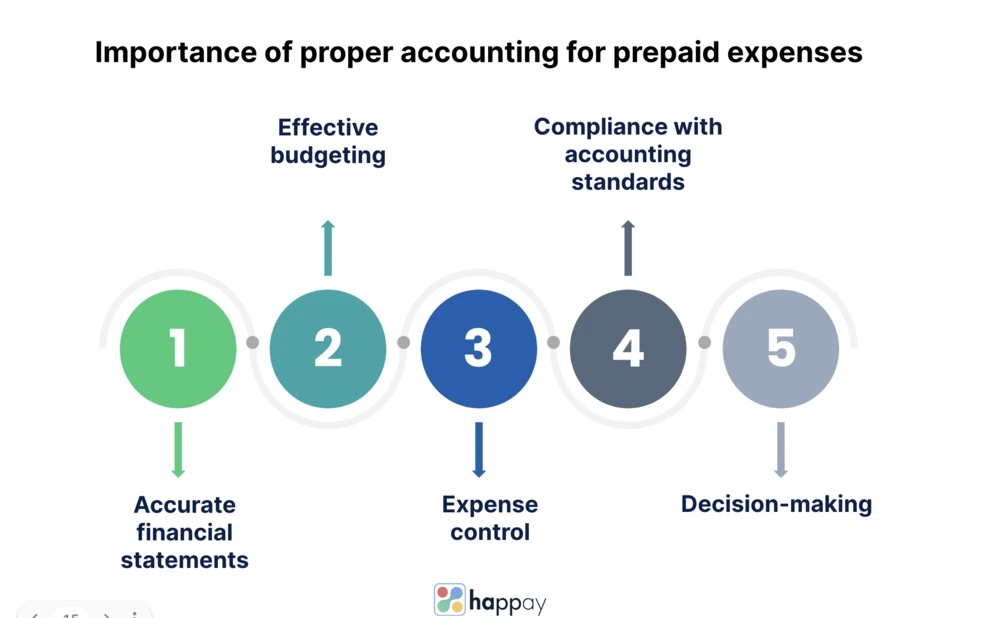Last Updated on November 28, 2025
Introduction to prepaid expenses
Prepaid expenses are expenditures made in advance for goods or services your organization will receive or consume in the future. Doesn’t it seem like a simple concept? However, their proper management is crucial for maintaining accurate financial records, forecasting cash flows, and ensuring your organization’s financial stability.
Essentially, it represents an asset on your company’s balance sheet that will be gradually consumed over time. They can include expenses such as prepaid insurance premiums, prepaid rent, or even prepaid subscriptions for software services.
By recognizing and accounting for prepaid expenses, you can distribute their costs over the appropriate accounting periods, avoiding sudden impacts on your financial statements and allowing for more accurate budgeting and forecasting.
In this article on prepaid expenses, we will explore the definition, accounting treatment, and best practices for effective management. By grasping the intricacies of this financial concept, you will be empowered to safeguard your organization’s financial interests, eliminate surprises, and optimize your financial planning.
Quick Read: 10 Best Expense Management Software and Tools
What are prepaid expenses?
Prepaid expenses refer to costs incurred by a business for goods or services that are yet to be received or consumed. In simple terms, it involves making advance payments for future expenses. These expenses are recorded as assets on the balance sheet since the company has already paid for them but has yet to benefit from them.
These commonly include rent, insurance premiums, subscriptions, and maintenance contracts. By prepaying these expenses, businesses can secure favorable terms, ensure uninterrupted service, and sometimes even receive discounts.
Proper accounting and recognition of prepaid expenses are essential for accurate financial reporting and effective budget management.
Suggested read: Discretionary Expenses: Definition, Types, and Budgeting
Importance of proper accounting for prepaid expenses
Proper accounting for of these expenses is crucial for businesses. Here’s why.

1. Accurate Financial Statements
Correctly accounting for prepaid expenses ensures that financial statements reflect the company’s actual financial position. It prevents misrepresentation of expenses and provides a realistic snapshot of the business’s financial health.
2. Effective Budgeting
Budgets and forecasting is an essential part of any business. Tracking such expenses helps businesses plan their budgets more effectively. By knowing when expenses will be incurred in advance, companies can allocate funds accordingly and avoid cash flow problems.
3. Expense Control
Accounting for prepaid expenses enables businesses to monitor and control their costs. It allows them to review and assess the value and necessity of prepaid services, ensuring that resources are used wisely and efficiently.
4. Compliance with Accounting Standards
Correctly accounting for advance-paid expenses ensures compliance with accounting standards and regulations. It helps companies adhere to generally accepted accounting principles (GAAP) and provides transparency in financial reporting.
5. Decision Making
Accurate tracking and accounting of prepaid expenses provide businesses with reliable data for decision-making. It helps evaluate the financial impact of prepayments, determine the feasibility of contracts, and assess the overall financial implications for the company.
Must Read: 6 Best Cash Flow Management Software
Are Prepaid Expenses Assets?
These expenses are asset accounts for organizations. Organizations make advance payments for goods or services you have yet to receive. These payments are recorded as a prepaid expense on your balance sheet. You have paid for future benefits or services.
By treating prepaid expenses as assets, you acknowledge their economic value and recognize that they represent a valuable resource for your organization. If utilized within one year, they are classified as current assets. They are classified as non-current assets when used beyond the next accounting period.
Internal and external stakeholders, including investors, lenders, and shareholders, rely on accurate financial statements to evaluate the financial health of your business. Classifying prepaid expenses as assets allows for accurate financial reporting. For instance, it ensures your balance sheet reflects the true financial position of your organization by accounting for the resources you have at your disposal.
Treating prepaid expenses as assets also enables effective budgeting and cash flow management. By recording them on your balance sheet, you have a clear overview of your future obligations and can allocate funds accordingly. It helps you avoid liquidity issues and ensures that you have sufficient resources to cover your advance-paid expenses when they become due.
Furthermore, recognizing these expenses as assets facilitates compliance with accounting standards and principles, such as generally accepted accounting principles (GAAP) or International Financial Reporting Standards (IFRS). These standards require businesses to correctly classify and disclose such expenses as assets, ensuring transparency and consistency in financial reporting.
Types of Prepaid Expenses
1. Prepaid Rent
A common form of prepaid expense, prepaid rent, is the advance payment made by your organization for using a property or space over a specific period. Here’s a breakdown of prepaid rent, its advantages, disadvantages, and a few examples.
1.1 Definition
Prepaid rent is an amount paid in advance by organizations to secure the right to use a property or space for a designated period. It typically involves signing a lease agreement and making a lump sum payment covering several months or even years of rent.
1.2 Advantages
- Cost Savings: Prepaying rent often allows businesses to negotiate favorable terms, such as discounted rates or incentives, resulting in long-term cost savings.
- Financial Planning: By prepaying rent, businesses can better forecast and plan their cash flow and budgeting, knowing that the rental expenses are covered for a specific period.
- Stability and Security: Prepaid rent assures secured occupancy, minimizing the risk of sudden rental rate increases or eviction.
1.3 Disadvantages
- Opportunity Cost: Prepaying rent means tying up a significant amount of capital that could be used for other business purposes, limiting liquidity and potential investment opportunities.
- Lease Termination: If a business needs to terminate the lease before the prepaid period ends, it may face challenges in recovering the prepaid amount or negotiating a partial refund.
- Flexibility Constraints: Prepaying rent reduces the flexibility to adjust to changing business needs or relocation plans during the prepaid period.
1.4 Examples
- Company C&H pays a lump sum of ₹60,000 to secure office space for two years, resulting in a prepaid rent expense of ₹30,000 per year.
- Restaurant C&H signs a lease agreement and pays six months’ rent in advance to secure a prime location, benefiting from a 10% discount on the rental rate.
- Retail Store C&H pre-pays three months’ rent to secure a commercial space in a busy shopping center, allowing them to start operations immediately.
Also, Read: 10 Best Business Budgeting Software & Tools
2. Prepaid Insurance
A frequently-used prepaid expense category, prepaid insurance refers to the advance payment made by businesses to secure insurance coverage for a specified period.
2.1 Definition
Prepaid insurance is any payment made by an enterprise to an insurance provider to obtain coverage against potential risks or losses over a specific period. The payment is made before the insurance policy’s effective date and is recorded as a prepaid expense on the company’s financial statements.
2.2 Advantages
- Cost Savings: By prepaying insurance premiums, organizations can negotiate discounts or obtain more favorable rates, resulting in cost savings over the coverage period.
- Financial Planning: Prepaying insurance can help organizations forecast their expenses and budget better, knowing that insurance costs are covered for a specified timeframe.
- Continuous Coverage: Prepaid insurance provides uninterrupted coverage, ensuring that businesses are protected against unforeseen events or losses during the prepaid period.
2.3 Disadvantages
- Capital Tie-Up: Premium prepayments tie up capital that could be used for other business needs, potentially limiting liquidity and investment opportunities.
- Policy Changes: If a business needs to change its insurance policy during the prepaid period, such as adding or removing coverage, it may face administrative challenges and potential loss of prepaid amounts.
- Claims and Refunds: In the event of policy cancellations or adjustments, businesses may face complexities in obtaining refunds or properly accounting for the changes.
2.4 Examples
- 1. Manufacturing Company C&H pays an annual insurance premium of ₹10,000 upfront to secure property and liability coverage for their production facilities.
- 2. Professional Services Firm C&H pre-pays a three-year professional liability insurance policy, receiving a 15% discount on the total premium amount.
- 3. Retail Store C&H makes a lump sum payment of ₹5,000 for a comprehensive business insurance policy covering property, inventory, and general liability for a one-year period.
Quick Read: 10 Best Financial Management Tools for CFOs
3. Prepayment of Subscriptions and Memberships
3.1 Definition
Subscriptions to services and maintenance are critical to keeping your business operations running smoothly. In this regard, prepaying subscriptions and maintenance services can be common.
Here’s what you need to know about such prepayments.
3.2 Advantages
- Cost Savings: Prepaying subscriptions and maintenance services is an opportunity to secure discounted rates or special offers, resulting in cost savings over the prepaid period.
- Convenience and Efficiency: By prepaying these expenses, you ensure uninterrupted access to essential services or subscriptions, allowing for smoother operations without frequent renewals or interruptions in service.
- Budgeting and Cash Flow Management: Prepaying these expenses enables you to plan your budget more effectively, as you know the expenses are already covered for a specified duration. It reduces uncertainty and improves cash flow management.
3.3 Disadvantages
- Opportunity Cost: By prepaying, you are tying up your funds in advance, potentially limiting your available capital for other business needs or investment opportunities.
- Changing Needs: If your business requirements change or you no longer require the subscribed services or maintenance, such prepayments may pose refund or adjustment challenges.
- Vendor Reliability: Prepaying requires you to trust the vendor’s ability to deliver as promised. In case of vendor-related issues or disruptions, you may face difficulties in seeking refunds or resolving service interruptions.
3.4 Examples
- Software Company C&H pre-pays for a two-year subscription to a project management software tool, availing a 20% discount on the total subscription cost.
- Hospital C&H pre-pays for a three-year maintenance contract for medical equipment, ensuring regular servicing, repairs, and replacement parts at a fixed cost.
- Marketing Agency C&H pre-pays for an annual subscription to a marketing automation platform, gaining access to advanced features and dedicated customer support.
Must Read: 9 Best Vendor Payment Management Software
4. Other Types of Prepaid Expenses
There are other types of prepaid expenses in enterprises, such as prepaid licenses and prepaid advertising.
Prepaying for licenses allows you to secure access to software, patents, or intellectual property rights, ensuring their availability for a specified period. The advantages of such an expense include cost savings through negotiated discounts, assurance of resource availability, and improved financial planning.
Prepayment for advertising secures advertising space or services in advance, guaranteeing visibility for your business.
Limitations exist for both types of prepayment. Prepaid licenses may become obsolete if business needs change, while prepaid advertising commitments may not align with evolving marketing strategies.
It’s vital to assess the opportunity cost, flexibility constraints, and vendor reliability when considering these prepaid expenses to make informed decisions that align with your evolving business requirements.
Suggested Read: TOP 10 Financial Planning Tools That Accelerate Growth
How are prepaid expenses recorded in accounting?
Prepaid expenses are assets recorded on the positive side of the balance sheet. When you make a prepayment for goods or services yet to be received or consumed, it is initially recorded as a debit to the prepaid expense account. The credit is posted to the cash or accounts payable account, depending on the payment method.
As time passes and the prepaid expense is utilized or consumed, the asset is gradually reduced through an adjusting entry called amortization or recognition. This adjusting entry debits the appropriate expense account, such as rent expense or insurance expense, and credits the prepaid expense account.
The purpose of this process is to allocate the prepaid expense over the period during which it provides benefit or service to the business. By recording prepaid expenses in this manner, businesses ensure accurate financial reporting and proper matching of expenses with the corresponding revenue or period of benefit.
Where do prepaid expenses appear on a balance sheet?
Prepaid expenses appear as current assets on the balance sheet. They are typically listed under the “Assets” section, specifically within the subcategory of “Current Assets.”
Current assets are expected to be utilized or converted into cash within the next operating cycle or one year, whichever is longer. Since prepaid expenses represent resources paid for in advance but have yet to be consumed or utilized, they are classified as current assets.
The balance sheet provides a snapshot of a company’s financial position at a specific time, and listing prepaid expenses as current assets reflects their economic value and the benefits they will provide in the near term.
Also, Read: Income Statement: What is it, Types, Components, How to Prepare and Read
Prepaid expenses vs. Accrued expenses
Differentiating Factors |
Prepaid Expenses |
Accrued Expenses |
|---|---|---|
|
Definition |
Payments made in advance for goods or services yet to be received or consumed. |
Costs incurred but not yet paid or recorded in the accounting books. |
|
Timing of Recognition |
Recorded as current assets on the balance sheet until they are consumed or utilized. |
Recorded as current liabilities on the balance sheet until they are paid off. |
|
The Nature of Expense |
Represents future benefits or services that have been paid for in advance. |
Represents expenses already incurred, but payment is pending. |
|
Accounting Treatment |
It is initially recorded as a debit to the prepaid expense account and a credit to cash or accounts payable. Adjusted through amortization over time to match the expense with the benefit period. |
Recognized through an adjusting entry that debits the expense account and credits the corresponding accrued liability account. |
|
An Example |
C&H, the enterprise, pre-pays Rs. 50,000 for an annual software license. Initially recorded as a prepaid expense. Each month, Rs. 4,167 (Rs. 50,000/12 months) is recognized as an expense on the income statement. |
C&H accrues Rs. 30,000 as salaries expenses for the current month but will pay the employees in the next month. The accrued expense is recorded until payment is made. |
|
Financial Reporting |
Reduces profit in the current period due to the amortization of the prepaid expense over time. |
Increases expenses in the current period, affecting the company’s net income. |
|
Impact on Cash Flow |
Cash outflow occurs at the time of prepayment. |
Cash outflow occurs when accrued expenses are eventually paid. |
|
Importance in Budgeting |
Helps in better cash flow management and budget planning by knowing future expenses are covered. |
Provides a more accurate reflection of current expenses to facilitate effective budgeting and financial planning. |
|
Occurrence in Financial Statements |
Appears as current assets on the balance sheet. |
Appears as current liabilities on the balance sheet. |
Read More: What Are Accrued Expenses? Types, Benefits, and Examples
Accounting treatment of prepaid expenses
1. Identifying and Measuring Prepaid Expenses
- Prepaid expenses are recognized when payments are made for goods or services consumed or utilized in the future.
- These expenses are measured at their original cost, paid in advance.
2. Is Prepaid Expenses a Current Asset?
- Yes, these expenses are classified as current assets on the balance sheet.
- They are expected to be consumed or utilized within the next operating cycle or one year, whichever is longer.
3. Amortization and Recognition of Prepaid Expenses Over Time
- Prepaid expenses are amortized, meaning their cost is systematically allocated over the period of benefit or use.
- The amortization period depends on the nature of the prepaid expense and its expected consumption or usefulness.
4. Prepaid Expenses – The Journal Entry
- Initially, prepaid expenses are recorded with a debit to the prepaid expense account and a credit to cash or accounts payable.
- Over time, adjusting entries are made to recognize the prepaid expense portion corresponding to the consumed or utilized amount.
5. Prepaid Expenses on Financial Statements
- On the balance sheet, prepaid expenses appear under current assets until fully consumed or utilized.
- On the income statement, the amortized amount is recognized as an expense, reducing the company’s net income for the corresponding period.
- Proper accounting for these expenses ensures accurate financial reporting and aligns expenses with the periods in which they provide value to the business.
Importance of Monitoring and Reevaluating Prepaid Expenses
Monitoring and reevaluating this category of expenses ensures financial efficiency and effective resource allocation. Regular reviews help businesses identify cost-saving opportunities, assess the relevance of prepaid commitments, and optimize cash flow.
By staying proactive, companies can adjust their financial strategies to align with changing needs, prevent wasteful spending, and make informed decisions. Monitoring and reevaluating prepaid expenses empower businesses to stay agile, maximize value, and maintain a competitive edge in their financial management practices.

1. Regularly reviewing prepaid expenses is crucial
Regularly reviewing prepaid expenses is essential for businesses to maintain financial accuracy and efficiency. Monitoring these expenses allows companies to track their resource allocation, identify cost-saving opportunities, and ensure that prepayments align with changing business needs. Timely reviews enable businesses to adjust their budgeting and cash flow management strategies, making effective decisions to optimize their financial resources.
2. Monitoring strategies and reevaluating prepaid expenses
Implementing effective monitoring strategies and regularly reevaluating prepaid expenses helps businesses stay proactive and agile. Companies can closely monitor these expenses by identifying discrepancies, potential overpayments, or underutilized resources.
Reevaluation allows businesses to assess the continued relevance and value of prepaid services, ensuring that their financial commitments align with the company’s current goals and requirements.
This process enables businesses to adapt to changing circumstances, optimize cash flow, and adjust to remain competitive and financially prudent.
3. Potential risks and consequences of neglecting prepaid expenses
Neglecting to monitor and reevaluate prepaid expenses can lead to significant financial risks and adverse consequences for businesses. Unused or expired prepaid services can result in financial losses, tying up capital that could have been invested elsewhere. Failure to align this category of expenses with actual resource usage may result in missed opportunities for renegotiating contracts or securing better terms.
Must Read: 10 Best Expense Reporting Software Systems and Tools
Best Practices for Managing Prepaid Expenses
- Establishing an Effective System: A robust tracking system is essential to monitor and manage prepaid expenses accurately. This system should record the details of prepayments, such as amounts, payment dates, and expiration periods, providing a comprehensive overview of prepaid commitments.
- Conducting Periodic Reviews and Audits of Prepaid Expenses: Regular reviews and audits ensure that prepaid expenses align with business needs and remain relevant. Analyzing prepaid services’ utilization helps identify underutilized resources or opportunities for cost optimization.
- Optimizing Cash Flow and Budgeting through Prepaid Expense Management: Strategically managing prepaid expenses enables businesses to optimize cash flow and budgeting. Forecasting future prepaid outflows allows businesses to plan their expenses more effectively, ensuring sufficient funds for other critical expenditures.
- Regular Review and Reconciliation: Frequently reviewing and reconciling prepaid expense records with financial statements enhances accuracy and transparency. This practice helps detect discrepancies and ensures that prepaid expenses are appropriately recognized on the balance sheet and income statement.
- Proper Documentation and Record-keeping: Maintaining meticulous documentation of prepaid expense transactions is crucial. Proper records facilitate easy retrieval and provide evidence for auditing purposes, enabling businesses to stay compliant with accounting standards and regulations.
- Monitoring and Adjusting Amortization Schedules: Monitoring the amortization of prepaid expenses helps companies accurately spread costs over the benefit period. Adjusting amortization schedules when circumstances change ensures that expenses are matched with their respective periods of service or use.
- Collaboration with Vendors and Service Providers: Open communication and collaboration with vendors and service providers can lead to mutually beneficial arrangements, leading to better vendor management. Negotiating favorable terms and conditions for prepaid expenses can result in cost savings and improved service delivery.
Quick Read: Vendor Management System (VMS): Benefits, Features & TOP Systems
Conclusion
Businesses can make informed decisions and optimize their financial resources by understanding prepaid expenses’ advantages, disadvantages, and accounting treatment.
Regularly monitoring and reevaluating these expenses ensure that resources are utilized efficiently and align with changing business needs. Prioritizing prepaid expense management empowers businesses to achieve financial stability and strategic growth in a dynamic and competitive market environment.
FAQs
Prepaid expenses are costs paid in advance for goods or services yet to be received or consumed. For instance, a company paying for a year’s insurance premium upfront is a prepaid expense.
An example of a prepaid asset is when a business pays rent in advance for several months, making it a prepaid expense until the rental period is utilized.
In the accounting journal entry, prepaid expenses are recorded by debiting the prepaid expense account and crediting the cash or accounts payable account.
Prepaid expenses are not revenue; they are classified as current assets until consumed or utilized.
Prepaid expenses involve advance payments for future costs, while deferred expenses are costs incurred but recognized as expenses in future periods.
Examples include prepaid rent, insurance premiums, subscriptions, maintenance contracts, and annual licenses.
Prepaid expenses are advance payments made by the company, whereas unearned revenue involves advance receipts from customers for goods or services not yet provided.
Prepaying offers cost savings, uninterrupted services, and improved financial planning and cash flow management.
Prepaid expenses are paid in advance and recorded as assets, while regular expenses are incurred and recorded immediately as expenses.
Organizations incur prepaid expenses to secure favorable terms, ensure continuous services, and budget effectively.
Prepaid expenses appear as current assets on the balance sheet and are gradually recognized as expenses on the income statement over time.
Yes, if prepaid expenses are no longer applicable, they can be reversed or refunded, depending on the terms of the contract or agreement.
Prepaid expenses are carried on the balance sheet until their benefits are consumed or utilized, typically within one year.
Depending on tax regulations, prepaid expenses may be eligible for tax deductions in the year they are incurred or when they are utilized.
Prepaid expenses can improve cash flow management by allowing businesses to plan expenses in advance and avoid sudden cash outflows, ensuring better financial stability.










Discussion about this post